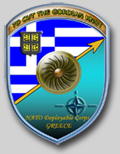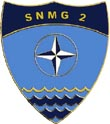 W
WThe Multinational CIMIC Group is a multinational civil-military co-operation unit of NATO, led and supported by the Italian Army. Based in Motta di Livenza in Veneto the unit consists of armed forces personnel from Italy, Greece, Hungary, Portugal, Romania and Slovenia. The unit is administratively assigned to the Italian army's Engineer Command and affiliated with NATO's Supreme Headquarters Allied Powers in Europe and consists of a multinational headquarters, a multinational Command and Logistic Support Company, an Italian National Support Command, and CIMIC Battalion with personnel from the Italian Armed Forces.
 W
WThe Multinational Specialized Unit (MSU), is a unit of the Italian Carabinieri, dedicated to the military missions abroad, including the military and civilian police tasks, peacekeeping operations, crowd and riot control.
 W
WThe NATO Training Mission-Iraq (NTM-I) was established in 2004 at the request of the Iraqi Interim Government under the provisions of UN Security Council Resolution 1546. The aim of NTM-I was to assist in the development of Iraqi security forces training structures and institutions so that Iraq could build an effective and sustainable capability that addressed the needs of the nation. NTM-I was not a combat mission but was a distinct mission, under the political control of NATO's North Atlantic Council. Its operational emphasis was on training and mentoring. The activities of the mission were coordinated with Iraqi authorities and the US-led Deputy Commanding General Advising and Training, who was also dual-hatted as the Commander of NTM-I. The mission came to an end in December 2011.
 W
WNaval Striking and Support Forces NATO (STRIKFORNATO) is the principal naval service command of the North Atlantic Treaty Organization's (NATO) Allied Command Operations (ACO), replacing Naval Striking and Support Forces Southern Europe (STRIKFORSOUTH). STRIKFORNATO is commanded by Commander United States Sixth Fleet, and it is the only command capable of leading an expanded maritime task force.
 W
WThe III Hellenic Army Corps / NATO Rapid Deployable Corps – Greece, abbreviated NRDC-GR, is an operational headquarters of the Hellenic Army, intended for the direction of international operations undertaken by the European Union and NATO. The HQ was originally going to replace the III Army Corps of the Hellenic Army altogether, taking control of its rapid response units, but this was changed in 2009, so that the two HQs essentially co-exist as a joint formation, each controlling different units of the old Army Corps. The Corps is based in the city of Thessaloniki since 1946.
 W
WThe SHAPE International Band is the organizational military band of NATO, subordinated to the Supreme Allied Commander Europe (SACEUR) from the Supreme Headquarters Allied Powers Europe headquarters in Mons, Belgium. It is composed of musicians of the United States Armed Forces as well as musicians from other allied countries. It has a size of 18 professional musicians under the direction of Chief Warrant Officer 4 James Bettencourt from the United States Army.
 W
WStanding NATO Maritime Group One (SNMG1) is one of NATO's standing naval maritime immediate reaction forces. SNMG1 consists of four to six destroyers and frigates. Its role is to provide NATO with an immediate operational response capability.
 W
WStanding NATO Maritime Group 2 (SNMG2) is a North Atlantic Treaty Organisation (NATO) standing maritime immediate reaction force. SNMG2 consists of four to six destroyers and frigates. Its role is to provide NATO with an immediate operational response capability.
 W
WStanding NATO Mine Countermeasures Group 1 (SNMCMG1) is a North Atlantic Treaty Organisation (NATO) standing mine countermeasures immediate reaction force. Its role is to provide NATO with an immediate operational response capability.
 W
WStanding NATO Mine Countermeasures Group 2 (SNMCMG2) is a North Atlantic Treaty Organisation (NATO) standing mine countermeasures Immediate Reaction Force. Its role is to provide NATO with an immediate operational response capability.